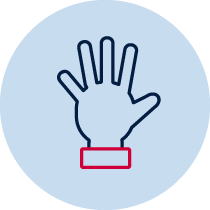Multiplication and division – birds in the playground
Students model and use equal groups of objects as a strategy for multiplication.
 |
 |
 |
 |
 |
| Practical | Build and make | Resource required | Teacher observation | Individual |
Number – multiplication and division
- uses a range of mental strategies and concrete materials for multiplication and division MA1-6NA
- describes mathematical situations and methods using everyday and some mathematical language, actions, materials, diagrams and symbols MA1-1WM
Content
Model and use equal groups of objects as a strategy for multiplication
- determine and distinguish between the 'number of groups' and the 'number in each group' when describing collections of objects (Communicating)Literacy
- find the total number of objects using skip counting
National Numeracy Learning Progression mapping to the NSW mathematics syllabus
When working towards the outcome MA1-6NA the sub-elements (and levels) of Additive strategies (AdS6), Multiplicative strategies (MuS4-MuS5), Number patterns and algebraic thinking (NPA5) and Interpreting fractions (InF1) describe observable behaviours that can aid teachers in making evidence-based decisions about student development and future learning.
Materials
- access to more than 20 counters if required
- birds in the playground (DOCX 298.1KB)
Teacher instructions
The purpose of this task is to gauge students’ understanding of multiplication and division concepts such as:
- recognise patterns
- describe pattern relationships
- rhythmic or skip counting
- the use of equal groups of objects
- determine and distinguish between the 'number of groups' and the 'number in each group' when describing collections of objects
Show the diagram of the 8 birds to the student.
Teachers read the question to the student and observe the student's response, looking for the strategy that the student is using (dealing objects by one, skip counting, using known facts, etc).
Once the student has a solution, ask 'How did you work out your answer?'
Student instructions
There are 8 birds in the playground, how many eyes do they have altogether? You may use the picture or the counters to help you.
Possible areas for further exploration
Students will answer the question using a familiar strategy which may or may not be the most sophisticated strategy.
Where to next?
Skip count by twos, fives and tens starting from zero (ACMNA012)
- count by twos, fives and tens using rhythmic counting and skip counting from zero
- use patterns on a number chart to assist in counting by twos, fives or tens (Communicating)
- model and use equal groups of objects as a strategy for multiplication
- model and describe collections of objects as 'groups of',
- recognise the importance of having groups of equal size (Reasoning)
- determine and distinguish between the 'number of groups' and the 'number in each group' when describing collections of objects (Communicating)
- find the total number of objects using skip counting
Explore concepts through action stories that involve naturally occurring ‘equal groups’, e.g. the number of wheels on 4 toy cars, the number of fingers in the room, the number of cakes on a baker’s tray ...., and stories from Children’s Literature, for example, ‘Counting on Frank’, Rod Clement or ‘The Doorbell Rang’, Pat Hutchins.
Please note:
Syllabus outcomes and content descriptors from Mathematics K-10 Syllabus © NSW Education Standards Authority (NESA) for and on behalf of the Crown in right of the State of New South Wales, 2012